- 2023
- Jun
- 10
Dayton purchase: An HP3440 NIXIE DVM
One of the things I keep an eye out for is NIXIE equipment. I have a few pieces in service, and as these devices age they are getting harder to find. People such as myself buy them for parts and spares, and godless heathens destroy them for the tubes so as to build clocks. It’s not uncommon to find an empty chassis where all the boards were discarded when the tubes were removed.
Fortunately, this wasn’t one of those. Cosmetically, it was in ok shape. Covers were all present, feet and bail were there, it looked it’s age. Wood screws holding the bottom cover on suggested someone had been in it and lost parts, so that was taken into account. The vendor said that it worked, but examination and experience said it probably didn’t. I was right.
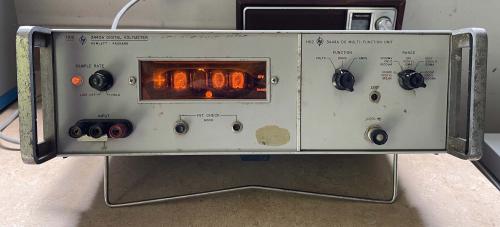
The aforementioned screws told a story that someone had probably opened it, let it set, and someone else hastily tied it up for sale. It had several non-factory features installed, including both the clogged-with-mud input terminals, and the rust-onna-nut package for the plug-in module. This thing probably sat in a barn or garage for a while.
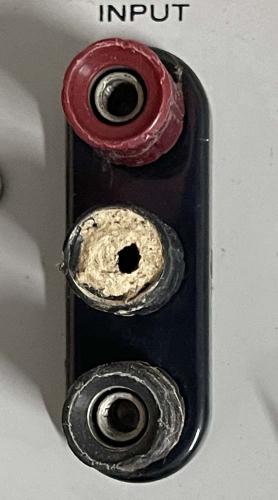
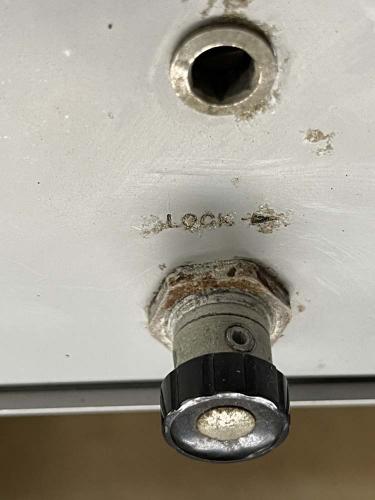
As Shango066 says, the first thing you do is look at the device thoroughly to note anything unusual. The inside had several things to see. The device had about the level of dirt I’d expect, although it’s not really that old for one of these units. Date codes on capacitors suggested this had been made (or repaired) at some point in the early 80s. That it didn’t have ICs for the driver cards suggests it’s not one of the last ones, but it’s getting close.
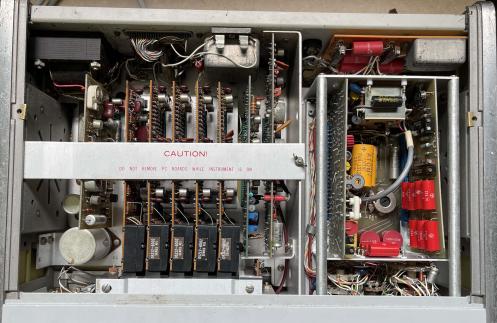
The first thing of note was the missing fuse at the top of the device. This wasn’t as much of a concern as you’d think, as it fed the recorder output instead of being a fuse for one of the power supplies.
The plugin module had some interesting things going on as well. One of the cards was not seated properly in it’s slot - this could be from vibration or other mechanical stress, so that was simply a matter of pulling it out and re-seating it properly. The card was slightly warped, so it had been like that for some time.
The most interesting thing here was the two orange dry electrolytics in the middle of the module. This most certainly isn’t factory, and as they were just hanging loose and kind of tied together. It’s pretty obvious this isn’t a factory part - if you hadn’t guessed that already.
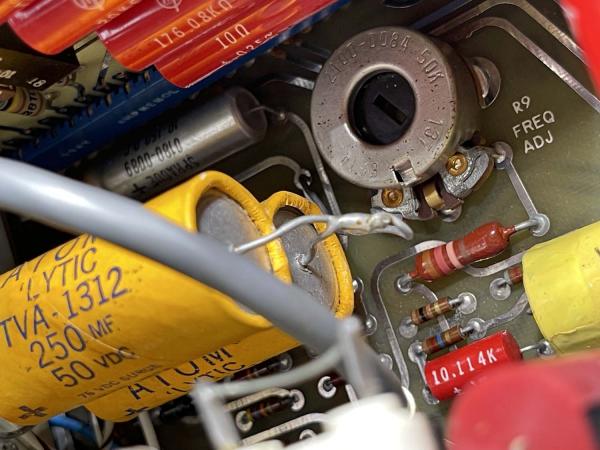
I don’t know that you could get that style of capacitor in the 80s, so those may have been hanging around in someone’s parts bin, or may have even been rescued from an old television set before making their way into this device. If I plan on putting this module into service in one of my other devices, it will need to be repaired correctly.
Note the ultra-precision resistors present in this module. 10.114k (!)
The bottom wasn’t as bad, but still showed some work.
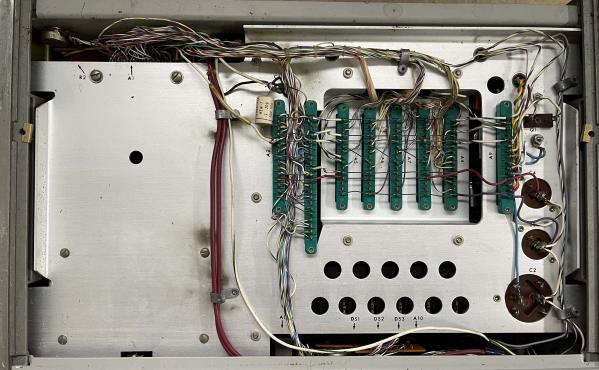
There was some dirt along the wires indicating it had been in use for quite some time, and one of the clamps was broken. I’m not sure if this was due to age or someone moving wires frequently, but it’s not that big of an issue. The big takeaway here is the rat’s nest in the upper left hand corner of the unit. The string ties had all been removed and this bundle had been poked at numerous times. Nothing was broken or showed signs of insulation damage, so I ignored it and moved on.
So…what’s actually wrong with this unit? As you can see from the first picture, almost all of the tubes light up. The second numeric tube has some bad segments, but that’s to be expected. This unit simply didn’t DVM. Normally, the neon lamp to the left will flash, one flash per read. This one did not, it was like it was in hold mode. You could mess with the 8000 button, and the sample rate control to get it to manually change, but it was not performing those reads automatically like it should.
Often times, that will be because the cards are in need of an edge cleaning, so I decided to do that. You simply pull the card, clean the fingers with a pencil eraser, make sure it free of debris, and re-insert. I have to do this to most of my units once a year or so.
This is the power supply card. Notice that there’s been a lot of repair to the unit, as evidenced by the flux-coated joints. This is not how HP would have left anything from the factory. There’s also a bit of corrosion on some of the larger joints, as evidenced by the darkened solder. This has been exposed to some dampness at some point in it’s life.
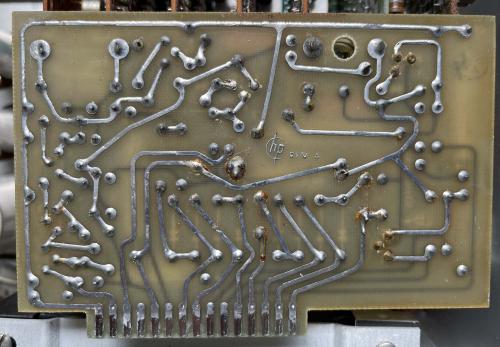
The fingers weren’t that bad, normally they exhibit marks where they’ve been placed and removed multiple times. This may have just been out a few times. Power supply is operational, so nothing to do here other than clean and replace.
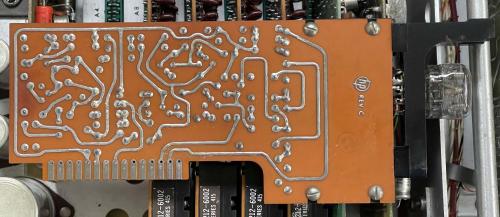
This is one of the NIXIE driver cards. The fingers on this didn’t indicate any removal, and none of these cards showed any repairs.
How does this work? These are an up-counter with a wheatstone bridge. One of the bridge sides is a ramp voltage, another side is the unknown input. The ramp voltage increases and the cards count up, when the bridge becomes balanced the unit stops counting and displays the unknown input on the tubes. Of particular note is how HP decoded the output - the black “socket” for the tube contains a photoconductive plate with neon bulbs driven by the flip-flops on the card. Depending on what sequence of bulbs is lit, certain parts of the photoconductive plate are active and drive the segments of the display tube. It’s fascinating how they did that and is worth a paper of it’s own. Maybe for a future post?
Here’s the card that’s most likely the problem. The ramp generator. It had marks on the fingers indicating this had been in and out of it’s socket many times. It, for some reason, also had a lot of bug debris on it. Only this card hard that, so I wonder if this was pulled from another unit originally - usually when insects get into a device like this, their crap is all over the thing.
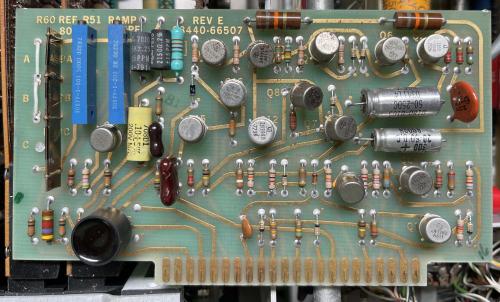
If you look closely, Q8 right in the middle of the card has been lifted as if someone was troubleshooting the device before I got it. So this is indeed the problem (probably!) and if I wanted to fix the device, I’d start here.
But, that’s the thing. I bought this knowing that it probably didn’t work due to the condition of the unit. It was purchased solely for parts, and parts it is. I’m not sure how much time I want to spend on this, but who knows. I may have a spare ramp card in my box ‘o junk, as I’ve purchased these units before in tear-down condition. I might wait until the snow flies and dig that box of cards out of storage and see what’s in there.
Until then, this unit is going to serve it’s function of being a parts donor for my other units.
Stay tuned, next week there’s one more show’s worth of pictures to post until late summer. The Butler Breezeshooter’s hamfest was a nice show, and I brought home stuff I didn’t need. As usual!